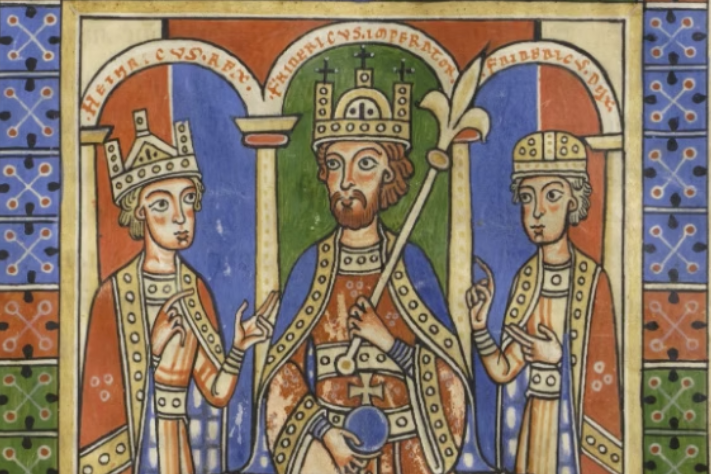"And Name My Name" (1972/1974)
- Jon Nelson
- 13 hours ago
- 6 min read
But one of the soldiers with a spear pierced his side, and forthwith came there out blood and water. John 19:34
“Your name is ape,” the man said, smiling in his pain.
There are elements of sourness in Lafferty that surface in his thinking about eschatology, and I haven’t worked out how to understand them. “And Name My Name” is bleak and beautiful. It denounces humanity. A figure who is certainly Christ—still bearing the wound from Longinus’s spear from which water and blood flowed and a pain in his side—summons the procession of the creatures, and the last men are judged insufficient and cast away as secondary apes.
Theologically, there are ways to approach this. One could say that all the men and women whom Lafferty believed died with grace, or were harrowed from Hell, receive their rewards, but that God ultimately decides humanity wasn’t worth the candle. The sticking point is, why would God incarnate Himself as a man if this were to be the ending?
It makes me think “And Name My Name” is another of Lafferty’s eschatological horror stories, like “Ginny Wrapped in the Sun.” It is not something he believed possible, but something he thought men and women should be made to hear, a thought experiment. At the same time, the sourness is part of his imagination, and it plays a significant role in the logic of Serpent’s Egg, another of his great ecological fantasies. My view is that it is one of his stories that addresses wrongness with strategic wrongness to jolt the reader: “Keep making that face and it’ll freeze that way.”
As a child, I learned to love Mark Twain. We had his complete works at home. Some of my earliest reading memories are of going through his short stories, sketches, and speeches. When I was six or seven, my family—thinking they were giving me some harmless edutainment—let me watch The Adventures of Mark Twain (1985), a claymation film with a set piece loosely based on “The Mysterious Stranger.” The Mysterious Stranger segment is worth watching.
Twain was never the same for me afterward. He kept being funny and surprising, but there was always something sinister behind it—an abyss yawning beneath the irony that made the humor more intelligible and more stinging. Twain’s friend, the great American writer William Dean Howells, once said of Twain, “He liked beyond all things, to push to the bitter end . . .”
Lafferty’s Shining Man is not like Twain’s late figures, because he is still clearly Christ, God and man, but there is nonetheless a profound disappointment in humanity. Lafferty is funny, as Twain is funny, and it is often difficult to determine where the humor bottoms out. In both, there is a place where humor abruptly ends. Not that there is much humor in “And Name My Name.”
It is one of Lafferty’s melancholy stories. His usual posture is the zoon anthrōpikon, but here he says: man, you were unworthy of such a noble gift. Your species is finished. The divine breath that filled man in a moment of cosmic exhalation is inhaled again.
"You haven't any name," he says. "Your particular species vanishes now . . . It has never been a real species . . . You were the Second Age of Apedom, and an abridged and defective age it has been . . . You are secondary ape."
One of the profundities of the sorry is that Christ will still be man, but man will no longer be man. The image of what is special about man being excarnated, and of man not even able to understand what is being said, that he held a position that was not a species like the others but gets to be one now, is one of Lafferty’s most horrifying metaphysical visions, though the story has largely been ignored.
A group of seven intelligent apes, remnants of a bygone era of dominion, travel through the Kurdish highlands with "a touch of furtiveness." Led by the brindled Joe Sunrise, they recall their "primary day . . . when we named the world," and bewail the current age under an "Interloper" that has left them diminished. They are "seven apes from anywhere / A-walking up a hill," as Lafferty puts it, holding onto the belief that the current ruler is just "a sad aberration of ourselves." Maybe this day will mark a return to the true order of creation.
Their pilgrimage is part of a larger, remarkable convergence, another version of what Lafferty, drawing on scholastic thought, called the procession of the creatures. He uses this in "Animal Fair." Here, he combines it with two moments of Biblical procession: Adamic naming and Noahic refuge. The world is filled with reports of Invisible Animals and prodigies that defy logic: talking bears ordering drinks in Istanbul, extinct Irish Elk reappearing, and then there are the whales in Kurdistan. These travelers are not the entire species but small elites representing large multitudes, select groups who have retained the gift of speech that most of their species lost long ago. They are the saving remnants that still contain more of the Logos. This great migration, drawing creatures from every continent, is a message to those who have ears to hear that the current age is ending. Judgment is at hand.
In parallel, seven exceptionally accomplished humans gather in a hotel in Mosul, here an index of the cradle of civilization. A verbal summons doesn’t bring them together. Instead, Lafferty calls it a sort of psychobiological urge. These men and women, with "brilliance dripping off them like liquid jewels," are the pinnacle of human intellect and culture. They interpret the strange events as a new epiphany, perhaps The Second Age of Man as foretold by Clarke, and see themselves as the seven magic people who will act as spokesmen for their species (one of Lafferty’s few direct references to other pieces of science fiction in his stories), ready to greet the new world order they are certain to lead. They are unaware that they regard themselves too highly.
On an animated hill teeming with creatures from across the globe, a shining man appears to re-establish the world's hierarchy, a figure pretty clearly Christ in his glorified flesh. In a process that is both simultaneous and existential for each species, he names them and assigns their place. The procession of the creatures is to be reordered. When he talks to the apes, Joe Sunrise protests, "No, no, no, we are men . . . We are not ape." But the Christ-figure is firm. He reminds them of their own past glory before confirming their new reality: "Your name is ape. Now go and fill your niche." Accepting this, the apes depart. They shed their robes and their higher consciousness, and Lafferty says they are more fulfilled in their true nature.
Finally, our surrogates, the seven human beings approach the shining man, expecting "confirmation and approval." Instead, the shining man dismisses them. In the language of the New Testament, he spits these last men out. "You haven't any name," he says. "Your particular species vanishes now . . . It has never been a real species," as if to remind them that they had something higher but now it can only be understood from its most debased point of vantage. He refutes their claim to be the First Age of Mankind. He says, "You were the Second Age of Apedom, and an abridged and defective age it has been." After deconstructing their civilization as mindless and grotesque, largely because it is a culture of self-worship, he gives them a species name, as if to say, you wanted to be a Linnean data point, so have it. You are secondary ape. The magic vanishes from them, and they depart, speechless forever, going back to their decaying "world-hives . . . not really knowing anything ever again."
This is perhaps the most despairing story Lafferty ever wrote, and it should be a pendant for anyone thinking about the zoon anthropikon and Serpent’s Egg. How ironic that it is one of his most controlled, dense, and beautifully written stories.




